Engaging in the pursuit of cultivating an aquarium can bestow upon you a sense of fulfillment and tranquility. Nevertheless, ensuring the maintenance of an optimal temperature within your aquatic haven’s confines can prove quite a formidable task, particularly during the scorching summer season. While commercial options for aquarium chillers are available, they often come with a hefty price tag. However, fear not, for you can embark on a cost-effective endeavor by employing your do-it-yourself expertise to build your own aquarium chiller. In this comprehensive guide, I shall walk you through a step-by-step process, enlightening you on the construction of a personalized aquarium chiller, thereby guaranteeing the provision of a cool and serene habitat for your underwater companions.

An Overview of Aquarium Chillers
Aquarium chillers are devices that help regulate the temperature of the water in your aquarium, ensuring it stays within a suitable range for the specific species of fish and other aquatic organisms you have. They work by removing excess heat from the water and dissipating it, effectively cooling down the aquarium. If you’re looking for a more cost-effective option, you can build your own aquarium chiller.
Benefits of a DIY Aquarium Chiller
Creating your own aquarium chiller offers several advantages:
An Economical Solution
Commercial aquarium chillers can be quite expensive and strain your budget. By taking a do-it-yourself approach, you can significantly reduce costs while achieving comparable results.
Customizability
Building your own aquarium chiller allows you to customize the design and specifications to meet your specific requirements. You can adjust the size, cooling capacity, and other parameters to suit your aquarium setup.
Satisfaction of Building It Yourself
Constructing your own aquarium chiller can be a rewarding and educational experience. It provides an opportunity to learn new skills and knowledge while giving you a sense of pride in creating a functional device for your aquarium.
Materials and Tools Required
Before you start building your DIY aquarium chiller, gather the following materials and tools:
- Copper tubing
- PVC pipe
- Insulating foam
- Water pump
- Aquarium-safe silicone sealant
- Drill
- Saw
- Pipe cutter
- Screwdriver
- Insulated electrical wire
- Digital thermometer
Related: How to Convert Freshwater Aquarium to Saltwater
Step-by-Step Guide to Building an Aquarium Chiller
Design and Planning
Begin by conceptualizing and planning the structure of your DIY aquarium chiller. Consider the dimensions of your aquarium, the required cooling capacity, and the available space for the chiller. Sketch the design and create a comprehensive list of all the necessary components.
Constructing the Cooling Coil
Using the pipe cutter and copper tubing, create a tightly coiled cooling coil that will be submerged in your aquarium. Ensure that there is enough room for water to flow through the tubing. Seal the ends of the tubing with aquarium-safe silicone sealant.
Assembling the Chiller Box
Construct a box using PVC pipes and fittings, ensuring that it is large enough to accommodate the cooling coil and water pump. Drill holes for the water inlet and outlet.
Installing the Cooling Coil and Water Pump
Place the cooling coil inside the chiller box and secure it in place with insulating foam. Attach the water pump to the inlet of the cooling coil. Connect the outlet of the cooling coil to the water inlet of your aquarium.
Insulating the Chiller Box
Cover the chiller box with insulating foam to prevent heat transfer and enhance the cooling efficiency of the chiller.
Connecting the Electrical Components
Wire the water pump and any additional electrical components following safety guidelines. Ensure that all connections are secure and properly insulated.
Testing and Troubleshooting
Fill your aquarium with water and activate the chiller. Use a digital thermometer to monitor the temperature and make any necessary adjustments to achieve the desired temperature range.
Maintenance Tips for Your Aquarium Chiller
To ensure the smooth operation of your DIY aquarium chiller, follow these maintenance guidelines:
- Regularly clean the cooling coil to prevent mineral buildup.
- Inspect the water pump for debris and ensure it is functioning properly.
- Thoroughly check the electrical components for any signs of damage or wear.
- Monitor the aquarium’s temperature regularly to ensure the chiller is performing effectively.
Safety Considerations
When building and using your DIY aquarium chiller, prioritize safety by keeping the following considerations in mind:
- Follow electrical safety protocols and ensure adequate insulation of all electrical components.
- Use materials that are safe for your aquatic pets and eliminate any potential harm.
- Exercise caution when handling tools and sharp objects, and wear appropriate protective gear.
Conclusion
It’s difficult to build your own aquarium chiller but by building your own aquarium chiller, you can maintain the ideal temperature for your aquatic pets without spending a fortune. This do-it-yourself project offers cost savings, customization options, and a sense of accomplishment. Remember to follow the step-by-step guide and prioritize safety throughout the construction process. Enjoy the journey of creating a comfortable and suitable environment for your beloved underwater companions!
Frequently Asked Questions (FAQs)
Yes, a DIY aquarium chiller can be used for both freshwater and saltwater aquariums. Ensure that the materials used are compatible with the saltwater environment.
The cost savings will depend on the size and specifications of the chiller you build. On average, DIY aquarium chillers can save you 50% or more compared to commercial alternatives.
Yes, you can adjust the cooling capacity of your DIY chiller by altering the length and diameter of the copper tubing used for the cooling coil.
It is recommended to clean the cooling coil every few months or whenever you notice a decline in cooling efficiency. Use a soft brush or cloth to remove any mineral deposits.
Certainly, DIY aquarium chillers can be designed and built to accommodate large aquariums. Make sure to calculate the appropriate cooling capacity based on the size and requirements of your specific setup.
